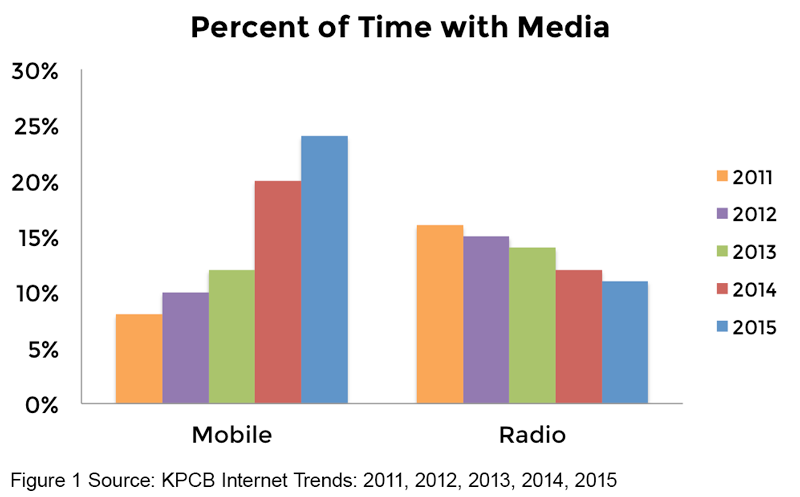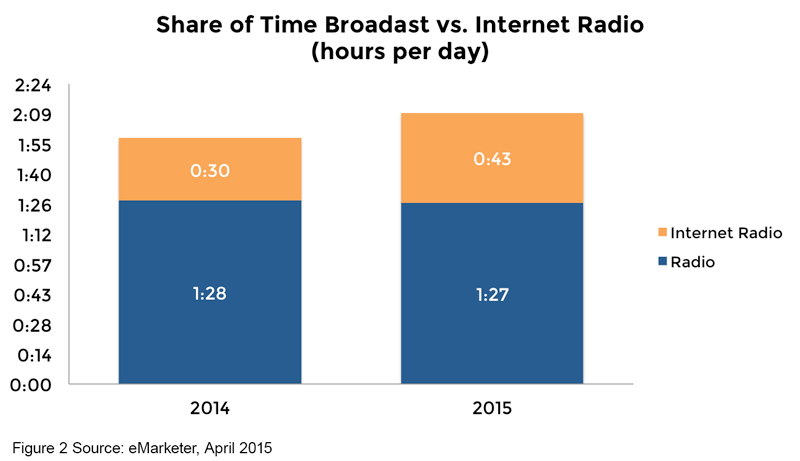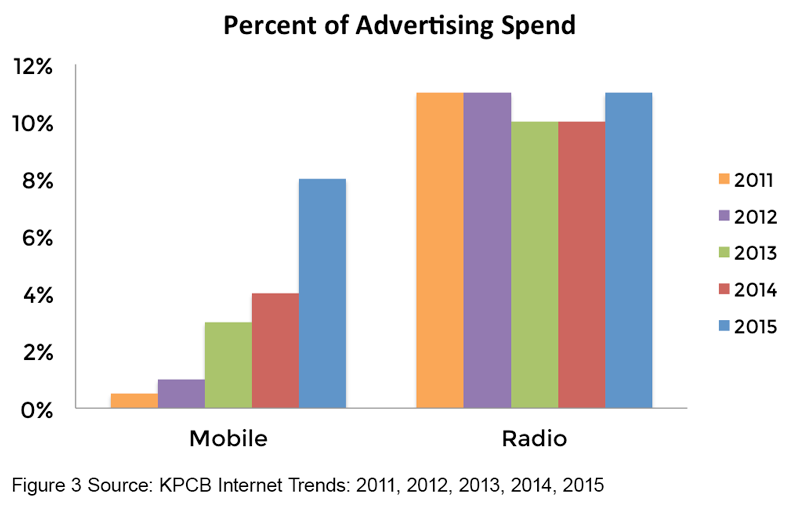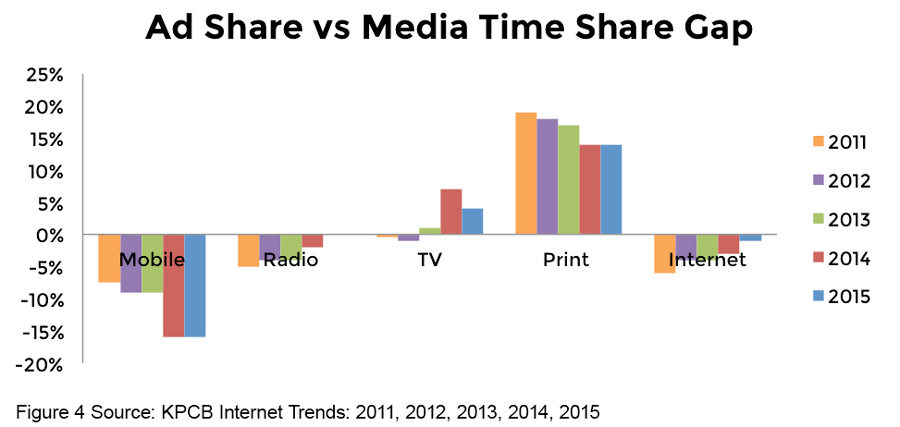Mary Meeker’s annual Internet Trends presentation is always highly anticipated. The 2015 edition provides 196 slides packed with data. Radio typically only shows up in one slide, but it is the most closely tracked chart each year. The chart represents time spent with media compared to advertising revenue. If you look back at five years of these presentations there is story to be told about radio’s past, present and future.
Time Spent Rising on Mobile, Falling on Radio
Consumers are making choices every day. Some of those choices involve how they spend their time with media. As you can see from Meeker’s analysis, time spent on mobile has grown from 8% to 24% between 2010-2014. That’s a nice 200% time spent increase in five years.
By contrast, broadcast radio’s share of time spent has fallen from 16% to 11% over the same period. In relative terms that is a 31% decline in time spent. About quarter of the loss is accounted for in a nominal decrease in time spent listening and the remainder is driven by media consumption growth that is going to mobile and other channels.
 Most broadcast radio executives are painfully aware of this situation. It speaks well of the sales acumen in the industry that ad revenue has remained flat or grown slightly despite falling time spent and falling share of media time. Of course, that doesn’t consider the impact of inflation discussed below.
Most broadcast radio executives are painfully aware of this situation. It speaks well of the sales acumen in the industry that ad revenue has remained flat or grown slightly despite falling time spent and falling share of media time. Of course, that doesn’t consider the impact of inflation discussed below.
By putting these trends side-by-side, it is logical to look at mobile as competitive with broadcast radio for consumer attention. However, Internet radio and streaming service time spent are actually embedded in that mobile number. Broadcasters with mobile streaming are picking up some of that increased time on mobile.
This is important to radio, because most of the growth in Internet radio and streaming services over the past five years have been on mobile. A comScore/Millennial Media study suggested that 95% of all Internet radio listening time is currently on mobile, with 79% of that specifically on smartphones.
Mobile Internet Accounts for All of Radio’s Growth
According to eMarketer, broadcast radio lost seven minutes of consumer media time between 2011 and 2015. Internet radio numbers aren’t available for that full period, but eMarketer does report a 13-minute increase in media time between 2014 and 2015 alone. It seems clear from this and earlier Edison Research data that Internet radio and streaming services on mobile are both displacing broadcast radio and contributing to net new audio listening time.
If we look more closely at the 2014 and 2015 numbers we can see that Internet radio accounts for all of radio’s listening growth and even captures the decline.
 Five years ago, Internet radio was a minor portion of consumer listening. In 2014, it climbed to 25% of “radio” listening time and it is expected to reach 33% for 2015. While broadcast radio in the U.S. declined only 7.4% in nominal terms over the past five years, it has lost a third of audio market share during that period. That share loss is showing up in some other numbers.
Five years ago, Internet radio was a minor portion of consumer listening. In 2014, it climbed to 25% of “radio” listening time and it is expected to reach 33% for 2015. While broadcast radio in the U.S. declined only 7.4% in nominal terms over the past five years, it has lost a third of audio market share during that period. That share loss is showing up in some other numbers.
The Bottom Line: Where Ad Dollars are Flowing
The first two charts are about winning the hearts and minds of consumers, the third and fourth charts are about winning the dollars of advertisers. In this case, we see mobile advertising revenue rising sharply and a seemingly flat trend in radio.
 However, a flat trend is actually a decline in revenue if we consider inflation. The 2010 broadcast radio revenue as reported by RAB was $17.3 billion. The cumulative rate of inflation between 2010-2014 was 8.6%. For the broadcast radio industry to maintain inflation-adjusted flat revenue, it would have needed to reach $18.8 billion in revenue in 2014. The reality was 2014 industry revenue of $17.5 billion. That reflects a $1.3 billion decline in inflation adjusted terms.
However, a flat trend is actually a decline in revenue if we consider inflation. The 2010 broadcast radio revenue as reported by RAB was $17.3 billion. The cumulative rate of inflation between 2010-2014 was 8.6%. For the broadcast radio industry to maintain inflation-adjusted flat revenue, it would have needed to reach $18.8 billion in revenue in 2014. The reality was 2014 industry revenue of $17.5 billion. That reflects a $1.3 billion decline in inflation adjusted terms.
Internet radio is heading in the other direction. From less than $100 million in advertising revenue in 2010, BIA/Kelsey pegged Internet radio revenue in 2014 at $2.1 billion. For 2015, eMarketer and BIA/Kelsey estimate a range between $2.75 and $2.90 billion in advertising revenue. Broadcast radio advertising revenue is falling in real terms, but Internet radio is growing dramatically.
Over-indexing and Under-indexing Risks and Rewards
Last week’s post by Pat Higbie discussed the under-indexing of Internet radio advertising revenue share compared to the consumer time spent with media. If you assume that advertising spend should be roughly equivalent to audience time with media, a channel that captures 10% of media consumption time would also capture 10% of advertising dollars. If you capture less advertising spend than time spent, you are under-indexing and over-indexing when you capture more.
Mary Meeker’s Internet Trends report provide a cross-industry analysis that we can apply to this concept of time spent versus advertising revenue indexing.
 You can see that Print media has dramatically over-indexed and TV has recently moved into over-indexing territory. By contrast Internet media under-indexed historically and is nearing parity in 2015.
You can see that Print media has dramatically over-indexed and TV has recently moved into over-indexing territory. By contrast Internet media under-indexed historically and is nearing parity in 2015.
Similarly, broadcast radio’s historic under-indexing seems headed toward zero. This might be viewed as a favorable trend driven by advertisers recognizing they should move spending to media where more consumers spend time. However, in this case the picture isn’t so rosy. All of gap narrowing for broadcast radio has come from a relative loss of consumer media time and no additional advertising spend.
In Meeker’s 2011 report, radio commanded 16% of consumer time with media. In the 2015 report, it had fallen to 11%. Meanwhile, advertising spend was constant at around 11%. If the trends continue, broadcast radio is at risk of over-indexing which generally precipitates an eventual decline as you can see from the TV and Print industry experience.
By contrast, mobile under-indexes and the gap has grown. That is happening because consumer media time is growing at a faster rate than advertising dollars are shifting to the media channel. This represents an opportunity to generate a rapidly increasing share of advertising dollars as marketers shift spending to follow the audience. You can see from the chart that Internet media has already taken advantage of this trend and mobile is expected to follow.
For Internet radio, this means that revenue growth rates can accelerate further and faster. eMarketer data show Internet radio and audio streaming services under-index by about 8%. That translates into a 2015 gap of $4.7 billion on top of the nearly $3 billion the industry is expected to collect from advertisers.
This means that even without further user growth, Internet radio could more than double advertising revenue just by closing the indexing gap. Of course, Higbie points out this will require Internet radio to deliver a better content interaction experience to complement the content consumption experience.
The $5 Billion Opportunity for Audio
Whether you look at time spent with media, time spent on media through digital versus analog channels or advertising spend, the future of radio is digital. Analog broadcast radio is not going away, but its ability to generate revenue and audience will increasingly be challenged by rapidly changing consumer behaviors.
If you are an Internet radio or streaming service pure play, the eMarketer and Mary Meeker data is all good news for you. Your key concern will be competition for the growth. If you are a radio broadcaster there is good news here as well. Hundreds of broadcasters have already taken their audio content online directly or in collaboration with mobile platforms such as jacapps. Your key strategy will be to augment the existing broadcast base by building an online mobile audience to monetize the biggest area of audio growth.
XAPPmedia’s CEO Pat Higbie will be covering these topics and more at the Hivio Audio Future Festival in Los Angeles on Friday, June 5th at 1:30pm EST/10:30am PST. You can watch the event live online at: http://livestream.com/accounts/421091/hivio
Related Posts
Internet Radio in Q1 – Ad Load Falls, New Advertisers Rise
Download the Internet Radio Ad Load Report – Holiday 2014
Internet Radio Trends Report 2015
